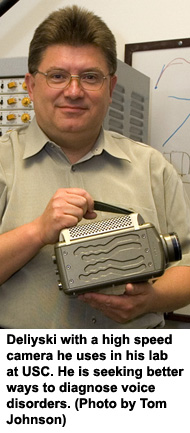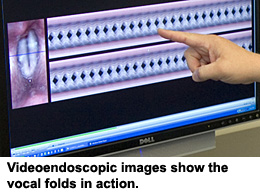


|
|
|
|
|
|
|
|
|
|
|
|
||||||||||||||
|
||||||||||||||
|
|
||||||||||||||
|
||||||||||||||
|
Posted
07/18/2007
And so is the Arnold School’s Department of Communication Science and Disorders where the Bulgarian-born Deliyski is embarking on a five-year study to develop a new methodology to help diagnose voice disorders and to advance the basic science of understanding voice. The research is supported by a $3.1 million RO1 grant from the National Institute on Deafness and Other Communication Disorders. The amount is about twice as large as most RO1 grants because the project requires the development of high-tech instrumentation and involves collaboration with five external institutions, Deliyski said. What Deliyski will be doing is examining the vocal folds of people using a probe (endoscope) fitted with a high-speed video camera that can take thousands of images per second illuminated with a high-intensity Xenon light. The images are stored on a computer and, when played back at 500 to 1,000 times slower speeds, allow for a slow-motion close observation of the vocal folds in action. USING LATEST TECHNOLOGY Put in technical language, Deliyski is using laryngeal high-speed videoendoscopy, the latest technology employed to view the larynx and vocal folds. This technology became commercially available about ten years ago and today is employed around the world to help understand an array of voice problems ranging from nodules and acid reflux damage to vocal fold paralysis and cancer. Deliyski is intimately familiar with the equipment, having helped develop much of it, first as principal scientist of Kay Elemetrics Corp. in Lincoln Park, NJ from 1992-1999 and later as director of research of Vocal Point, Inc. (Loquendo, Inc) in San Francisco from 1999-2002.
While videostroboscopy is in widespread use, Deliyski says in about half of the patients with voice disorders the vocal folds produce stroboscopic images that cannot be used to accurately diagnose voice problems. Resolving that issue will be a key focus of a team that Deliyski is putting together at his headquarters laboratory at USC. The lab, located on the 6th floor of the Williams-Brice Building, will be supported by a team that includes a mathematics professor, a speech-language pathology researcher, a statistician, a post-doctoral fellow with expertise in signal processing algorithms and a computer engineer. ADDITIONAL CLINICS CONTRIBUTE Besides the lab at USC, clinics in Charlotte, Charleston and Boston will be contributing data to the research, Deliyski said. Researchers and physicians at the Massachusetts General Hospital in Boston will use the same equipment to collect data and will report on patients’ conditions pre- and post-surgery. Because all of the data must be collected using the same equipment, high-tech manufacturers are part of the effort along with theoretical researchers who are doing modeling research at Bowling Green State University in Ohio and University of Iowa, and a physiology researcher at Seton Hall University in New Jersey. Deliyski said the high-speed videoendoscopic procedures produce huge computer video files that require a major storage capacity. He is currently putting together a 12-terabyte data server in his lab to store all incoming data and provide instant access to that data for his research team. The huge files also open new methodological challenges. “It’s one thing to be able to record the information you need, but you also need to be able to take advantage of it,” Deliyski said. An example is a high-speed video of vocal folds that takes 10 seconds to record in real time. Deliyski says when the same video is rerun in slow motion mode for diagnostic purposes, it can take up to three hours to view in its entirety. GOAL IS TO AUTOMATE TECHNIQUES “The diagnostic information we need is in that video,” Deliyski said. “The challenge is to develop automated techniques that extract the data that we believe to be clinically valid.” Deliyski has been on the USC faculty since 2002. He earned bachelor’s and master’s degrees in computer science from Sofia Technical University in Sofia, Bulgaria. He earned a doctorate in electrical engineering from the Bulgarian Academy of Sciences, also in Sofia, specializing in signal processing of acoustic voice signals. He maintained his focus on voice research through his post-doctorate studies in speech science at the University of Memphis in Memphis, Tennessee and through the ten years spent in the industrial sector, where he also received several federally funded research grants. |
| Columbia, SC 29208 • 803-777-7000 • sphweb@gwm.sc.edu | © University of South Carolina Board of Trustees |
 A
ten-year detour through the corporate world didn’t diminish the research
acumen of USC researcher Dr. Dimitar Deliyski. Truth is, he is the first
to admit he is a better scientist for the experience.
A
ten-year detour through the corporate world didn’t diminish the research
acumen of USC researcher Dr. Dimitar Deliyski. Truth is, he is the first
to admit he is a better scientist for the experience.  Kay Elemetrics had about 80 percent of the
worldwide market for laryngeal videostroboscopy and acoustic voice and
speech clinical instrumentation when it was purchased by PENTAX of
America, Inc. in 2005.
Kay Elemetrics had about 80 percent of the
worldwide market for laryngeal videostroboscopy and acoustic voice and
speech clinical instrumentation when it was purchased by PENTAX of
America, Inc. in 2005.